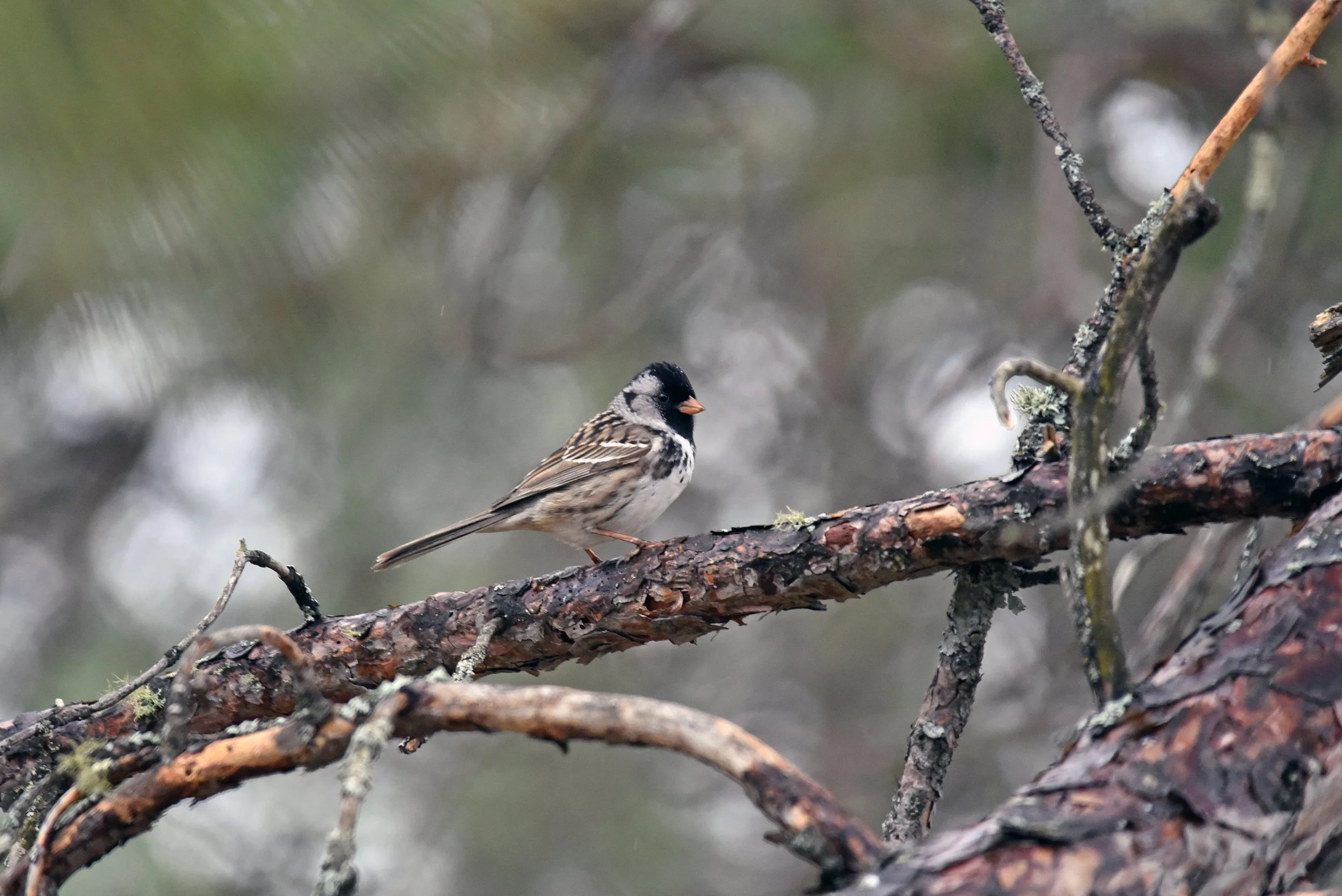Harris’s Sparrow found at Goose Pond on October 12 (photo by Aaron Holschbach).
“With all the Harris’s Sparrows around this fall I figured Goose Pond would be one of the best Columbia County locations to find my 'county lifer,'” wrote Aaron Holschbach in his eBird report from October 12. He identified one adult Harris’s Sparrow north of Prairie Lane before finding a second immature bird nearby. The next day, Michael Putnam submitted an eBird report with excellent descriptions of two immature Harris’s Sparrows. Interestingly, one of the sparrows briefly mobbed a Northern Shrike, which then chased off a White-crowned Sparrow before turning its attention to an eastern chipmunk. So it appears that at least three Harris’s Sparrows were present that weekend.
Harris’s Sparrows are large, chunky birds with long tails and pink bills. Immature sparrows have buffy brown heads and a white throat edged with black, sometimes with a streaky dark bib. When they become adults, they develop a black bib, face, and crown. Breeding adults have gray cheeks, while nonbreeding adults have buffy brown cheeks.
Sam Robbins wrote in Wisconsin Birdlife (1991) that Harris’s Sparrows were an uncommon migrant in Wisconsin. We rarely see them, but Sue vividly remembers seeing her first one in the mid-1970s—an adult male in breeding plumage during spring migration in northern Wisconsin. The first record of a Harris’s Sparrow in Columbia County was reported by Randy Hoffman at the Mud Lake Wildlife Area on May 16, 2008. Songbird box monitor Amy Ihlenfeldt found the first Harris’s Sparrow at Goose Pond Sanctuary at Hopkins Road Prairie on May 9, 2012 while checking Tree Swallow nest boxes. Prior to 2024, the only other two sightings of the species in Columbia County were near Laura Wentz’s farm on the far east side of the Baraboo Hills.
Harris’s Sparrow range map (courtesy of the Cornell Lab of Ornithology).
According to the Cornell Laboratory of Ornithology, the Harris’s Sparrow “breeds in boreal forest and shrubbery in the far north of central Canada, and winters in shrubby or weedy areas in the southern Great Plains.” Surveys conducted from 1970–2014 indicate a cumulative population decline of 63%. Their breeding population is estimated to be at 2 million. Partners in Flight includes the Harris’s Sparrow on their Yellow Watch List, which determines species of birds that have a high risk for extinction unless significant conservation actions are taken to reduce threats. Perhaps because of this bird’s restricted range, they are increasingly vulnerable to habitat loss. Changing agricultural practices that encourage removal of hedgerows, logging, resource extraction, and climate change play a role in their decreased numbers from breeding grounds in the Canadian arctic to wintering areas in Texas.
Aaron also wrote in his eBird report that it “took a while to sort through lots of sparrows.” He also counted 1 Clay-colored Sparrow, 36 White-crowned Sparrows, 47 Savannah Sparrows, 45 Song Sparrows (a record high count for Goose Pond), 7 Lincoln's Sparrows, and 8 Swamp Sparrows; another eBirder added 10 White-throated Sparrows that weekend. Most sparrows like shrubbery, and we have planted hundreds of shrubs outside of prairie burn units to provide more habitat for our native sparrows and other shrub-loving species like the Willow Flycatcher.
This fall, we have three sorghum food plots that also contain plenty of annual weeds like foxtail grasses. Foxtail provides excellent cover and food for sparrows and other winter birds. In September, around 175 Bobolinks used the food plots during migration. We plan on surveying bird use of our food plots this winter. If you would like to help count, please contact us at goosep@swibirds.org.
Written by Mark Martin and Susan Foote-Martin, Goose Pond Sanctuary resident managers
Cover image by Courtney Celley/USFWS. An adult Harris’s Sparrow in breeding plumage, with a gray face and black crown, face, and bib is perched on a branch.







